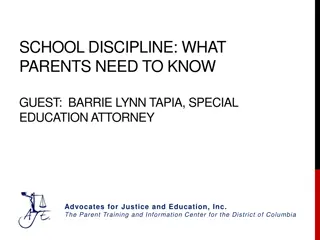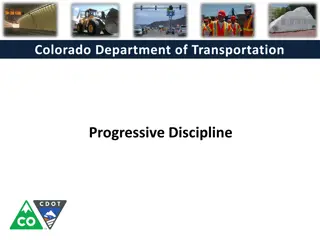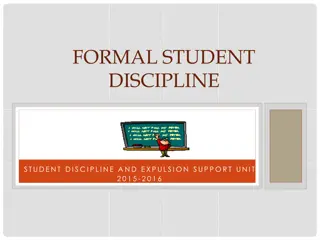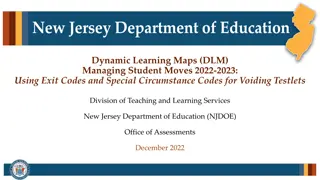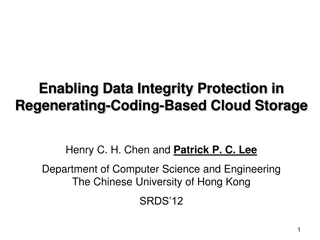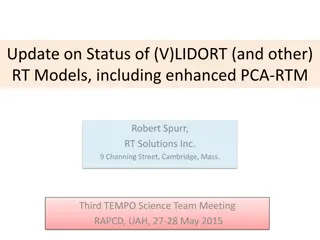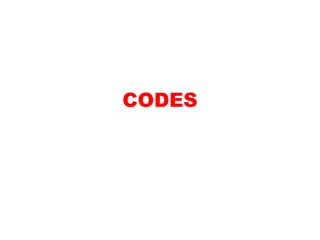Important Updates on Student Discipline and Education Codes in Texas
Learn about the new regulations and requirements impacting student discipline and education codes in Texas for the 2023-2024 school year. Topics include placement in alternative education programs, student dress policies, parental obligations, and consequences for possessing substances on school property. Stay informed to ensure compliance and support student success.
Download Presentation

Please find below an Image/Link to download the presentation.
The content on the website is provided AS IS for your information and personal use only. It may not be sold, licensed, or shared on other websites without obtaining consent from the author. Download presentation by click this link. If you encounter any issues during the download, it is possible that the publisher has removed the file from their server.
E N D
Presentation Transcript
Student Discipline 2023-2024 School Year
Introductions Student Discipline Specialist Office of School Safety Support and Security E-Mail: StudentDisciplineSupport@tea.texas.gov Office Phone: (512)463 - 9128 Mary Scott 30+ Years in Education 5 Years of Chapter 37, and Student Discipline 29 Years in Public School as a teacher, 504 Coordinator, Dyslexia Specialist, and Interventionist My Amazing Family
New from the 88thSession HB 3928 Texas Education Code (TEC), 37.006(p): On the placement of a student in a district alternative education program (DAEP), the school district must provide information to the student's parent/guardian regarding the process for requesting a full individual and initial evaluation of the student for purposes of special education services under TEC, 29.004. This information must also be included in the student s required personalized transition plan under TEC, 37.023, when returning to the regular education setting from DAEP or a Juvenile Justice Alternative Education Program (JJAEP).
New from the 88thSession HB 567 - TEC, 25.902: Prohibits any school district s student dress or grooming policy, including a student dress or grooming policy for any extracurricular activity, from discriminating against a hair texture or protective hairstyle commonly or historically associated with race. A protective hairstyle includes braids, locks, and twists. HB 3 - TEC, 25.002(a)(2): If a parent/guardian enrolls a child into a public school, the parent/guardian or the school district in which the child most recently attended school must furnish to the school district a copy of the child's records from the school the child s most recently attended a copy of the child's disciplinary record and any threat assessment involving the child's behavior conducted under TEC, 37.115.
New from the 88thSession HB 114 TEC, 37.006(a)(2)(C-1),(C-2), (D), Subject to the requirements of TEC, 37.009(a), a student must be removed from class and placed in a DAEP, if the student is observed on or within 300 feet of school property, or while attending a school-sponsored or school-related activity on or off school property: - (C-1) possessing, using, being under the influence, selling, giving, or delivering to another person marihuana or tetrahydrocannabinol (THC); - (C-2) possessing, using, selling, giving, or delivering to another person an e-cigarette; - (D) possessing, using, selling, giving, being under the influence, or delivering to another person an alcoholic beverage, or while under the influence of an alcoholic beverage commits a serious act or offense. *A felony alcohol offense under TEC, 37.007(a)(3) has been removed.
New from the 88thSession HB 114 TEC, 37.009(a-1): (a-1) If a DAEP is at capacity at the time a campus behavior coordinator is deciding placement for a student who engaged in conduct described under TEC, 37.006(a)(2)(C-1), (C-2), (D), or (E), the student must be: (1) placed in in-school suspension (ISS); and (2) if a position becomes available in the DAEP before the expiration of the period of the placement, the student must be returned to the DAEP for the remainder of the period.
New from the 88thSession HB 114 TEC, 37.009(a-2): (a-2) If a DAEP is at capacity at the time a campus behavior coordinator is deciding placement for a student who engaged in conduct described under TEC, 37.007, that constitutes violent conduct, a student who has been placed in the program for conduct described under TEC, 37.006(a)(2)(C-1), (C-2), (D), or (E): (1) may be removed from the program and placed in (ISS) to make a position in the program available for the student who engaged in violent conduct; and (2) if removed from the program under Subdivision (1) and a position in the DAEP becomes available before the expiration of the period of the placement, the student must be returned to the DAEP for the remainder of the period.
Student Code of Conduct Defined: The student code of conduct is the basis for a school district to outline and enforce expected student behavior. It states how and why students are disciplined to ensure expectations and actions are applied in an equitable and fair manner regardless of race, gender, ethnicity, economic disadvantaged status, or special education status. Notes: The board of trustees must approve any change to the student code of conduct. Open-enrollment charter schools code of conduct is addressed in Section VII.
Student Code of Conduct State Requirements: TEC, 37.001 The student code of conduct must specify and include: Circumstances in which a student may be removed from a regular classroom setting, campus, DAEP, or vehicle owned or operated by the district; Conditions that authorize or require an administrator to assign a suspension (TEC, 37.005), DAEP placement (TEC, 37.006), or an expulsion (TEC, 37.007); Guidelines for setting the length of term for a suspension, DAEP placement, or expulsion.
Student Code of Conduct State Requirements (continued): The following six items will be considered when deciding on a discipline action for any student: 1. Was the student s behavior committed in self-defense? 2. Was there a clear intent or lack of intent at the time of the student s behavior? 3. What is the student s disciplinary history? 4. Does the student have an identified disability that would substantially impair the student s capacity to appreciate the wrongfulness of the student s conduct? Best Practice: Outline due process procedures, including procedures for disciplining students with disabilities, in the student code of conduct
Student Code of Conduct State Requirements (continued): 5. Is the student in the conservatorship of the Department of Family and Protective Services? (Foster-Care Student) 6. Is the student s status homeless ? (The definition of homeless children and youths is found in 42 U.S.C. 11434a, McKinney Vento Act. See Texas Student Data System (TSDS) data element E1082 Homeless Status Code.)
Student Code of Conduct State Requirements (continued): Appropriate grade-level methods, including options, for managing students, disciplining students, and preventing and intervening in student discipline problems; Prohibition of bullying, cyberbullying, and making hit lists, along with the requirements for enforcing these prohibited behaviors; Procedures for notification to a student s parent/guardian of a violation of the student code of conduct that results in a suspension, a DAEP placement, or an expulsion; and Stipulations for refusal of entry or ejection from district property for people who are considered non-students and the appeal process under TEC, 37.105(h).
Student Code of Conduct What Disciplinary Actions Do We Report to TEA? Non-Reportable Disciplinary Actions TEA Reportable Disciplinary Actions Relocation/Reassignment to Another Appropriate Classroom All Suspensions Timeout Periods in Classrooms DAEP Placements (discretionary, mandatory) Detentions (before school, lunch, recess, after school) All Expulsions (discretionary, mandatory, without educational placement, DAEP, JJAEP)
Student Code of Conduct Suspensions Under TEC, 37.005: ISS (placement on campus counted present in attendance); Out-of-School Suspension (OSS) (not in school counted absent not in attendance); Temporary assignment while scheduling a DAEP placement or expulsion; Opportunity to complete course work missed because of the suspension (includes at least one option for receiving the course work that does not require the use of the internet); and Must not exceed three days (includes ISS and OSS) (TEC, 37.005(b))
Student Code of Conduct Suspensions (continued): OSS: Not authorized for students below grade three or experiencing homelessness unless the student engages in certain conducts outlined in TEC, 37.005(c)(1)-(3): 1) weapons under 46.02 or 46.05, Penal Code; 2) a violent offense under 22.01, 22.011, 22.02, or 22.021, Penal Code; or 3) selling, giving, possession, delivering, using, or under the influence of drugs or alcohol.
Student Code of Conduct DAEP Placement TEC, 37.006: Mandatory and discretionary removals must comply with Chapter 37 and the number of days assigned to DAEP must comply with the student code of conduct; Students must be enabled to perform academically at grade level; Entitled educational services and the opportunity to complete course work without interrupting the student s graduation plan must be provided; and A student who is younger then six years of age must not be placed in a DAEP (TEC, 37.006(I)).
Student Code of Conduct Expulsion Types: Expulsion without Academic Placement: A student is expelled without educational services. Expulsion with Placement in a DAEP: A student is expelled to an on- campus or off-campus DAEP with educational services provided through the DAEP. Expulsion with Placement JJAEP: A student is expelled to JJAEP with educational services provided through the JJAEP. This is in accordance with a Memorandum of Understanding (MOU) between each JJAEP participating school district and the county JJAEP.
Responsibilities Best Practices
Responsibilities and Suggested Best Practices Campus Behavior Coordinator (TEC, 37.0012): Each campus must have a designated campus behavior coordinator to maintain student behavior and implement the student code of conduct. Regardless of how the campus behavior coordinator is assigned (grade level, building, alphabet), the district website must include the name, an email, and a contact phone number of each campus behavior coordinator. Best Practice: Each campus should have the campus behavior coordinator s contact information easily accessible on its campus website.
Responsibilities and Suggested Best Practices Primary Duties of the Campus Behavior Coordinator: Ensure the student code of conduct is followed by all students and enforced consistently by appropriate staff; Promptly notify the parent/guardian of the student being placed in a disciplinary setting; Carry out the due process for each incident resulting in a student being removed from a regular education setting and placed in a disciplinary setting; Schedule a disciplinary conference for a DAEP placement no later than the third class day after the day on which a student is removed from class; and
Responsibilities and Suggested Best Practices Primary Duties of the Campus Behavior Coordinator (continued): Provide a transition plan for each student returning to the regular classroom from an alternative placement within five days of the return. Transition Plan: Must include recommendations for the best educational placement for the student from a variety of people associated with the district or campus. Must include information regarding the process for requesting a full individual and initial evaluation of the student for purposes of special education services (HB 3928) May include resources for assistance in academics, counseling, behavior management, and access to available mental health services. Note: Sample form is under Resources and Materials on the TEA Student Discipline Webpage.
Responsibilities and Suggested Best Practices Bullying Prevention Policies and Procedures (TEC, 37.0832): The board of trustees of each school district must adopt a bullying prevention policy, including any necessary procedures that: Prohibits the bullying of a student; Prevents and mediates bullying incidents between students that: interfere with a student's educational opportunities; or substantially disrupt the orderly operation of a classroom, school, or school-sponsored or school-related activities; Prohibits retaliation against any person, including a victim, a witness, or another person, who in good faith provides information concerning an incident of bullying;
Responsibilities and Suggested Best Practices Bullying Prevention Policies and Procedures (continued): Establishes a procedure for providing notice of an incident of bullying to: a parent/guardian of the alleged victim on or before the third business day after the date the incident is reported; and a parent/guardian of the alleged bully within a reasonable amount of time after the incident; Establishes the actions a student should take to obtain assistance and intervention in response to bullying; Sets out the available counseling options for a student who is a victim of or a witness to bullying or who engages in bullying;
IV. Responsibilities and Suggested Best Practices Bullying Prevention Policies and Procedures (continued): Establishes procedures for reporting an incident of bullying, including procedures for a student to anonymously report an incident of bullying, investigating a reported incident of bullying, and determining whether the reported incident of bullying occurred; Prohibits the imposition of a disciplinary measure on a student who, after an investigation, is found to be a victim of bullying, based on that student's use of reasonable self-defense in response to the bullying; Requires that discipline for bullying of a student with disabilities comply with applicable requirements under federal law, including the Individuals with Disabilities Education Act (IDEA) (20 U.S.C. 1400 et seq.); and
Responsibilities and Suggested Best Practices Bullying Prevention Policies and Procedures (continued): Complies with the minimum standards adopted by the agency under TEC, 37.0832(c-1). Notes: Adopted bullying prevention policies and procedures must be included in student and employee handbooks annually (as well as the district improvement plan (DIP), where applicable, under TEC, 11.252). Also, the procedure for reporting bullying must be posted on the LEA s Internet website to the extent practicable.
Responsibilities and Suggested Best Practices Corporal Punishment (TEC, 37.0011): The board of trustees may adopt a policy allowing corporal punishment as a method of student discipline. In order to prohibit the use of corporal punishment as a method of student discipline for their child, a student's parent/guardian must submit a written, signed statement each school year to the board of trustees in a manner established by the board. Conversely, a student s parent/guardian may withdraw the prohibition by submitting a written, signed revocation statement to the board at any time during the school year. Best Practice: Ensure these procedures are outlined in the student code of conduct.
Responsibilities and Suggested Best Practices DAEP: Each district s DAEP must be ready for operation during the entire school year. A district may not have a student assigned to the DAEP each school day, but the DAEP must be ready for operation for any placements or expulsions that might occur. Mandatory and discretionary removals to DAEP must comply with TEC, Chapter 37, and the student code of conduct. Note: Upon the placement of a student in a DAEP, the student's parent/guardian must be given information regarding the process for requesting a full individual and initial evaluation of the student for purposes of special education services under TEC, 29.004. (HB 3928)
Responsibilities and Suggested Best Practices Requirements for DAEP according to TEC, Chapter 37, and Texas Administrative Code (TAC): Setting must be somewhere other than a regular classroom setting and separate from students who are not in DAEP (except for summer programs); Location can be on or off a school campus. Generally, an off-campus facility is located on district property; Elementary students must be separated from secondary students; Procedures for enrolling and exiting DAEP must be established, including expectations and an individual plan for the student s success while in DAEP;
Responsibilities and Suggested Best Practices Requirements for DAEP according to TEC, Chapter 37, and TAC (continued): A pre- and post-assessment of academic growth in math and reading must be given to students placed in DAEP for a period of 90 school days or longer according to 19 TAC, Chapter 103, Health and Safety, Subchapter CC, 103.1203. This is in addition to the state standardized tests given each year; A school district may share a DAEP with one or more school districts; Best Practice: Ensure an MOU is in place if a DAEP is shared.
Responsibilities and Suggested Best Practices Requirements for DAEP according to TEC, Chapter 37, and TAC (continued): The student-to-teacher ratio is no more than 15:1. There must be one certified teacher for every 15 students enrolled in DAEP; Students are eligible for average daily attendance (must follow student attendance accounting rules in the Student Attendance Accounting Handbook); Schools must allocate same funds for students in DAEP as a regular classroom; Districts must provide other school districts with placement orders of students who unenroll and enroll in a new district before a DAEP term is complete;
Responsibilities and Suggested Best Practices Requirements for DAEP according to TEC, Chapter 37, and TAC (continued): Each district must annually include in the DIP and each Campus Improvement Plan, the performance of the DAEP student group; Curriculum must focus on English language arts, math, science, history, and self-discipline. A school is required to provide a student in DAEP courses necessary to fulfill the student s high school graduation program before the next school year. This can be offered through correspondence courses, distant learning, or summer school; Upon entering the DAEP, a student s parent/guardian must be notified in writing of the different methods the district will use to provide to the student the ability to complete course work required for the student s graduation plan. The notification must also state there is no cost to the parent/guardian;
Responsibilities and Suggested Best Practices Requirements for DAEP according to TEC, Chapter 37, and TAC (continued): Educational and behavioral needs must be met while a student is in DAEP; Districts may provide transportation to a different campus, guidance center, or community-based service to provide required education services for a student; Districts must cooperate with government agencies and community organizations that provide services to school districts and DAEPs; and Upon completion of a student's DAEP term, a transition plan transitioning the student back to the regular classroom must be provided.
Responsibilities and Suggested Best Practices Requirements for DAEP according to TEC, Chapter 37, and TAC (continued): Transition Plan from DAEP Back to Regular Campus: Establish a timeline for the student s transition from DAEP to the regular campus; Provide written notice to parents/guardians and the school administrator of the returning date of the student; and Provide the administrator of the home campus an assessment of the student s academic growth while attending DAEP. Note: This is different from the transition plan under TEC, 37.023 , when a student returns to the regular education setting implemented by the campus behavior coordinator.
Responsibilities and Suggested Best Practices Requirements for DAEP according to TEC, Chapter 37, and TAC (continued): All DAEP staff must participate in training programs on: Education; Behavior management; and Safety procedures that focus on positive and proactive behavior management strategies.
Responsibilities and Suggested Best Practices Requirements for DAEP according to TEC, Chapter 37, and TAC (continued): All DAEP staff must participate in training programs on: Education; Behavior management; and Safety procedures that focus on positive and proactive behavior management strategies. These training programs must also target prevention and intervention that include: Training on the education and discipline of students with disabilities who receive special education services; Social skills and problem-solving skills instruction that address diversity, dating violence, anger management, and conflict resolution teaching students how to interact with teachers, family, peers, authority figures, and the general public; and Annual training on established procedures for reporting abuse, neglect, or exploitation of students.
Responsibilities and Suggested Best Practices JJAEP: JJAEP is an academic program for students who have been expelled from school. According to TEC, 37.011(a), only a disciplinary alternative education program operated under the authority of a county juvenile board is considered a JJAEP. The juvenile board of a county with a population greater than 125,000 is required to develop a JJAEP, subject to the approval of the Texas Juvenile Justice Department (TJJD). However, the juvenile board of a county with a population of 125,000 or less can develop a JJAEP. Note: Requirements differ under TEC, 37.011, depending on the population size of the county. Further information regarding JJAEPs can be found in TEC, 37.011, and on TJJD s JJAEP webpage.
Students with Disabilities: Section 504 and Special Education
Students with Disabilities: Section 504 and Special Education Special education services shall be provided to eligible students in accordance with all applicable federal law and regulations, state statutes, rules of the State Board of Education and commissioner of education, and IDEA. Students with disabilities are not prohibited from a placement in a disciplinary alternative education setting. If a student with a disability is placed in an alternative education setting, the student must continue to receive educational services to enable the child to continue to participate in the general education curriculum and to progress toward meeting the goals of the student s individualized education plan (IEP) or Section 504 plan. A student served in special education must not be placed in an alternative setting for more than 10 days (consecutively or concurrently) without a change of placement Admissions, Review, and Dismissal (ARD) meeting.
Students with Disabilities: Section 504 and Special Education A student with a disability must have a manifestation determination review (MDR) to determine whether the behavior was due to the student s disability prior to assigning a discipline action that would impact Free, Appropriate, Public Education (FAPE). If the conduct is determined to be a result of the student s disability, the appropriate committee must meet to review and possibly modify the student s current IEP or 504 plan to address any behavior concerns. If the conduct is determined not to be a result of the student s disability, the student may be given a discipline action that a student without a disability would receive.
Students with Disabilities: Section 504 and Special Education A parent/guardian must be notified on the date a decision is made to make a removal that constitutes a change of placement of a child with a disability due to a student code of conduct violation. If a student who receives special education services is subject to an emergency placement or expulsion, the emergency placement or expulsion is subject to federal law and regulations and must be consistent with the consequences that would apply to a student without a disability. A parent/guardian has the right to appeal a decision made by an MDR or ARD committee.
Students with Disabilities: Section 504 and Special Education If a school district takes a disciplinary action regarding a student with a disability who receives special education services that constitutes a change in placement under federal law, the district must: Not later than the 10th school day after the change in placement: Seek consent from the student's parent/guardian to conduct a functional behavioral assessment of the student, if a functional behavioral assessment has never been conducted on the student or the student's most recent functional behavioral assessment is more than one year old; and Review any previously conducted functional behavioral assessment of the student and any behavior improvement plan or behavioral intervention plan developed for the student based on that assessment.
Students with Disabilities: Section 504 and Special Education As necessary, the district must: Develop a behavior improvement plan or behavioral intervention plan for the student if the student does not have a plan; or Revise the student s behavior improvement plan or behavioral intervention plan, for the student if the student has a plan. Note: For questions regarding students with disabilities, please contact the Texas Special Education Information Center (spedtex.org ). This is a resource to inform and support parents, teachers, and anyone committed to the success of children with disabilities.
Parents Guardians Students Rights
Parent/Guardian/Student Rights Parent/Guardian/Student Rights: Immediate written notice of disciplinary removals and placements; How classwork will be given to the student while placed out of the regular classroom; Disciplinary conference for a DAEP placement scheduled not later than the third class day after the day on which a student is removed from class; Participate in a proceeding before the board/board's designee, per district policy, if the student s placement in DAEP extends beyond 60 days or end of the next grading period, whichever is earlier; and Periodic review (not to exceed 120-day intervals) by the board's designee of the student's status, including academic status, and chance to advocate for the student's return to the regular classroom or campus.
Parent/Guardian/Student Rights Parent/Guardian/Student Rights (continued): DAEP Placement Conference: A conference with the appropriate due process must be held with the student, the student s parent/guardian, and the teacher removing the student from the classroom, if there is one; The student is entitled to written or oral notice of the reasons for the removal, an explanation of the basis for the removal, and an opportunity to respond to the reasons for the removal; The parent/guardian/student should be given information on the right to appeal and the process, if the student code of conduct supports appeals for DAEP placements; and The board or the board's designee must deliver to the student and the parent/guardian a copy of the order placing the student in a DAEP.
Parent/Guardian/Student Rights Parent/Guardian/Student Rights (continued): Expulsion Hearing: The expulsion hearing must be held with the appropriate due process; The student must not return to the classroom while waiting for the expulsion hearing; and A written invitation to the hearing must be given to the student, the student s parent/guardian, and another adult, at the student s discretion, who can provide guidance for the student. Note: The district must hold the expulsion hearing regardless of parent/guardian attendance.
Parent/Guardian/Student Rights Parent/Guardian/Student Rights (continued): Expulsion Appeals: Parents/Guardians/Students can appeal the campus behavior coordinator s decision to expel. The two steps to the appeal process for an expulsion are: 1. The board of trustees; if the parent/guardian/student is not satisfied, then 2. Trial de novo to the district court of the county in which the administrative office is located.







